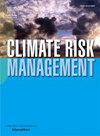季节气候预报对气候风险管理有多大益处?坦桑尼亚作物生产评估
IF 5
2区 环境科学与生态学
Q1 ENVIRONMENTAL SCIENCES
引用次数: 0
摘要
了解生长期条件对于有效的气候风险管理策略至关重要。季节性气候预报(SCF)是预测这些条件和指导农业风险管理的关键。然而,由于不确定性和缺乏了解等因素,小农对SCF的采用率较低。在这项研究中,我们评估了SCF在预测坦桑尼亚Kongwa地区生长季节条件和作物性能以及制定气候风险管理策略方面的益处。我们利用印度洋和太平洋地区的海温异常(SSTa),利用k近邻模型预测了季节性降雨的开始日期。与传统方法相反,该研究建立了使用降雨开始日期作为预测和描述生长期条件的标准。然后,我们利用农业生产系统模拟器(APSIM)和一个简单的生物经济模型,评估了在作物管理中使用SCF的预测技能和盈利能力。研究结果表明,海温对降水变率有显著影响,并能准确预测降水发生日期。事实证明,在描述关键生长期特征(包括降雨变率和分布)方面,发病日期比传统方法更有效。事实证明,将SCF纳入气候风险管理对玉米和高粱生产在农艺和经济上都是有益的。不使用SCF对作物生产构成更高的风险,产量损失的可能性为80%,特别是在晚发季节。我们的结论是,虽然SCF有潜在的好处,但它的产生和传播需要改进。加强推广机构网络可以促进小农更好地理解和采用。本文章由计算机程序翻译,如有差异,请以英文原文为准。
How beneficial are seasonal climate forecasts for climate risk management? An appraisal for crop production in Tanzania
Understanding growing period conditions is crucial for effective climate risk management strategies. Seasonal climate forecasts (SCF) are key in predicting these conditions and guiding risk management in agriculture. However, low SCF adoption rates among smallholder farmers are due to factors like uncertainty and lack of understanding. In this study, we evaluated the benefits of SCF in predicting growing season conditions, and crop performance, and developing climate risk management strategies in Kongwa district, Tanzania. We used sea surface temperature anomalies (SSTa) from the Indian and Pacific Ocean regions to predict seasonal rainfall onset dates using the k-nearest neighbor model. Contrary to traditional approaches, the study established the use of rainfall onset dates as the criterion for predicting and describing growing period conditions. We then evaluated forecast skills and the profitability of using SCF in crop management with the Agricultural Production System sIMulator (APSIM) coupled with a simple bio-economic model. Our findings show that SSTa significantly influences rainfall variability and accurately predicts rainfall onset dates. Onset dates proved more effective than traditional methods in depicting key growing period characteristics, including rainfall variability and distribution. Including SCF in climate risk management proved beneficial for maize and sorghum production both agronomically and economically. Not using SCF posed a higher risk to crop production, with an 80% probability of yield losses, especially in late-onset seasons. We conclude that while SCF has potential benefits, improvements are needed in its generation and dissemination. Enhancing the network of extension agents could facilitate better understanding and adoption by smallholder farmers.
求助全文
通过发布文献求助,成功后即可免费获取论文全文。
去求助
来源期刊

Climate Risk Management
Earth and Planetary Sciences-Atmospheric Science
CiteScore
8.20
自引率
4.50%
发文量
76
审稿时长
30 weeks
期刊介绍:
Climate Risk Management publishes original scientific contributions, state-of-the-art reviews and reports of practical experience on the use of knowledge and information regarding the consequences of climate variability and climate change in decision and policy making on climate change responses from the near- to long-term.
The concept of climate risk management refers to activities and methods that are used by individuals, organizations, and institutions to facilitate climate-resilient decision-making. Its objective is to promote sustainable development by maximizing the beneficial impacts of climate change responses and minimizing negative impacts across the full spectrum of geographies and sectors that are potentially affected by the changing climate.
 求助内容:
求助内容: 应助结果提醒方式:
应助结果提醒方式:


